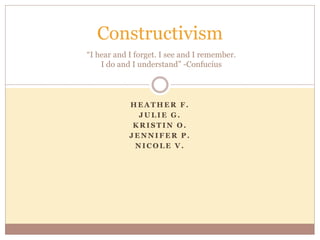
Constructivism
- 1. H E A T H E R F . J U L I E G . K R I S T I N O . J E N N I F E R P . N I C O L E V . Constructivism “I hear and I forget. I see and I remember. I do and I understand” -Confucius
- 2. Key Points Constructivism is a type of learning in which the learner constructs much of what he or she learns or comprehends. It involves active participation in the learning process by using critical-thinking skills to analyze a problem and create an understanding of the topic or problem. Learning involves linking new information with prior knowledge. Motivation is very important because the learner has to participate in learning in order to construct an understanding. Collaboration is important because it is insightful to explore others’ perspectives.
- 3. Theorist: Jean Piaget A psychologist who developed the cognitive learning theory by observing kids over the course of several year Defined four cognitive stages: Sensorimotor: learning takes place through children's senses and motor actions Preoperational: children begin to use symbols and images to mean something else Concrete Operational: children begin to learn factual information and different people's points of view Formal Operational: children think more abstractly and make their own beliefs and morals Piaget's 3 A‘s Adaption: Children's cognitive understanding or development at any given time Assimilation: how children fit the new information or experiences they have into their lives Accommodation: how the new information and experiences change their knowledge base and the world around them
- 4. Theorist: Jerome Burner Received A.B degree from Duke University in 1937 and Ph. D from Harvard in 1947 Published The Process of Education Founding father of the constructivist theory His theoretical framework is based on the theme that learners construct new ideas/concepts based on existing knowledge Theories emphasize the significance of categorization in learning Introduced the ideas of “readiness for learning” and spiral curriculum
- 5. Theorist: Les Vygotsky Les Vygotsky (1896-1934) was a major figure in Russian psychology. Vygotsky’s theory stresses the relations between the individual and society. He believed that it is not possible to understand a child’s development without some understanding of the culture in which the child is raised. In his theory, elementary cognitive functions are transformed into higher mental functions through interactions with more knowledgeable adults and peers. Vygotsky is known for the term: zone of proximal development which refers to the difference what children can do on their own and with the assistance of others. Vygotsky believed that language was the most important psychological tool that influences children’s development.
- 6. Theorist: John Dewey An educational psychologist who believed education was a social process in which learning should be student directed with teachers serving as a guide for resources. Believed students learn by doing. He founded several schools and has been called the Father of American Education.
- 7. Classroom Implications In Regards to the Teacher Teachers are there to guide the students and facilitate learning experiences. They should not simple lecture and require students to memorize what they are told. Build off and use student responses when making "on-the-spot" decisions about instructional strategies and content being taught. Provide adequate amount of time for students to construct their perspectives Provide hands on activities and allow students to use the computer to gain further knowledge and showcase what they have learned In Regards to the Students Explore the learning environment and make decisions based off trial and error. Apply prior knowledge and new information to construct new understandings Work in groups to collaborate and bounce ideas off each other. Use the internet to further their knowledge. Use the computer to showcase what they have constructed as their understanding of the topic, i.e. a PowerPoint presentation.
- 8. Constructivism in our Teaching Heather: “Piaget's constructivist thinking should be apart of classrooms today because it is targeted for children and can help teachers characterize their cognitive stages as the students progress in age.” Julie: “I will use constructivism in my teaching by having activities and projects that let my students do more of what they want to do with things that relate to their experiences that go along with the subject.” Kristin: “Vygotsky’s theory should be incorporated into the classroom because it gives teachers a better understanding of the differences in development among their students. Not all students develop the same way, this depends on their culture background and the types of adults and peers they interact with on a daily basis. Vygotsky believed that if a child receives appropriate help from and adult or peer, he or she generally performs at a higher level than those students who perform on their own. ” Jennifer: “Dewey’s theory should be incorporated into classrooms because it teaches students not to rely on teachers for everything. They learn by doing things themselves and it truly prepares them to become independent in society” Nicole: “I think that it is very important for teachers to allow their students to form their own perspectives of the world around them. I believe that children learn more by doing and are more interested in figuring things out for themselves than being lectured about topics. I will definitely use constructivism in my classroom to motivate students to learn for themselves.”
- 9. Works Cited http://alex.edfac.usyd.edu.au/methods/science/Constructivist_Teaching.html http://nursingcrib.com/wp-content/uploads/jean-piaget1-259x300.png http://www.cals.ncsu.edu/agexed/aee501/dewey.html http://www.teach- nology.com/currenttrends/constructivism/classroom_applications/ http://www.ndt- ed.org/TeachingResources/ClassroomTips/Constructivist%20_Learning.htm http://toolboxes.flexiblelearning.net.au/demosites/series12/12_09/toolbox12 _09/resources/training/book/qg/learntheory/constructivism_keypoints.htm http://www.todayinsci.com/B/Bruner_Jerome/BrunerJeromeThm.jpg http://www.lifecircles-inc.com/Learningtheories/constructivism/bruner.html "Lev Vygotsky -- History of Psychology." Les Vygotsky. Web. 22 Nov. 2010. <http://elvers.us/hop/index.asp?m=3&a=86&key=153>. Meece, Judith L., and Denise H. Daniels. "Chapter 3: Cognitive Development: Piaget"s and Vygotsky's Theories." Child and Adolescent Development for Educators. 3rd ed. New York, NY: McGraw-Hill, 2008. 165-68. Print